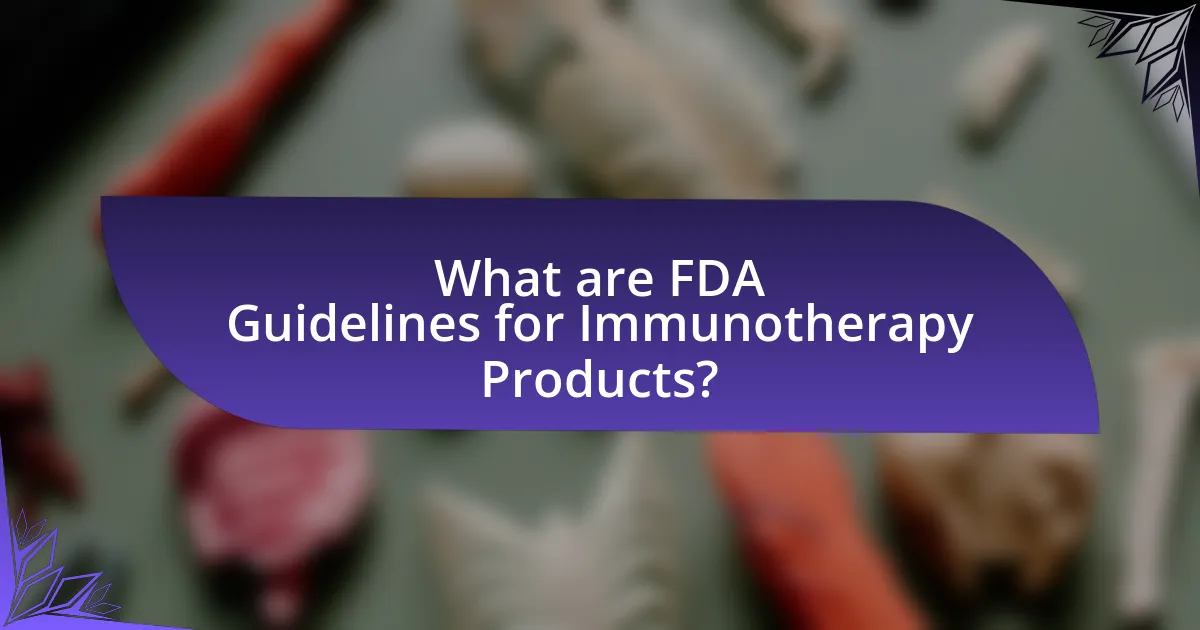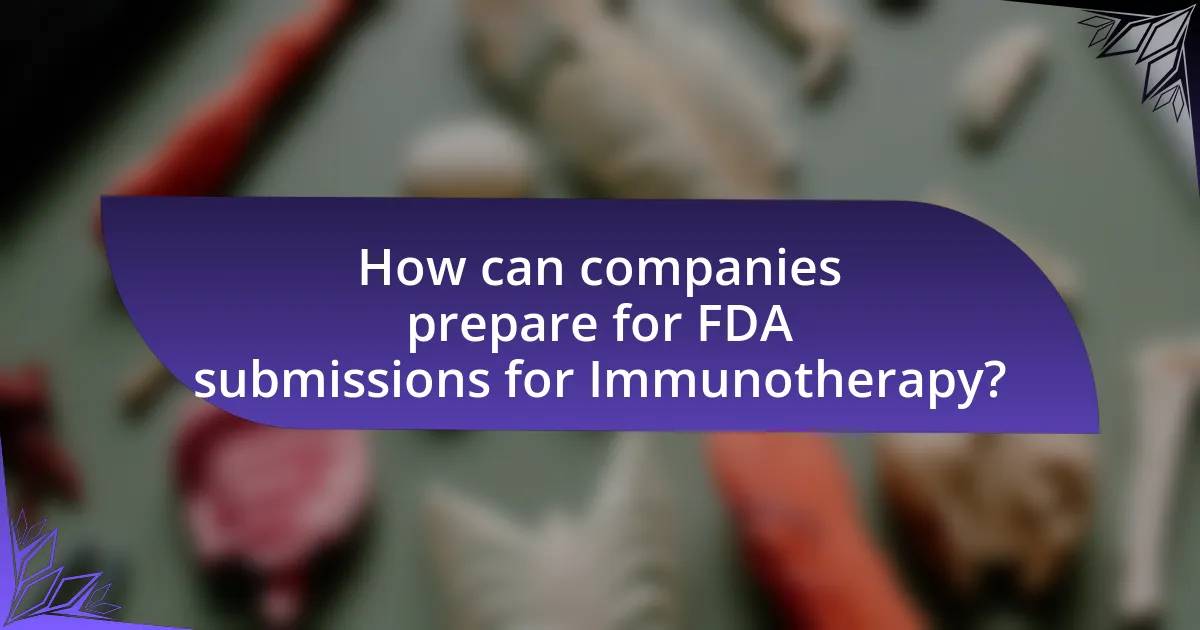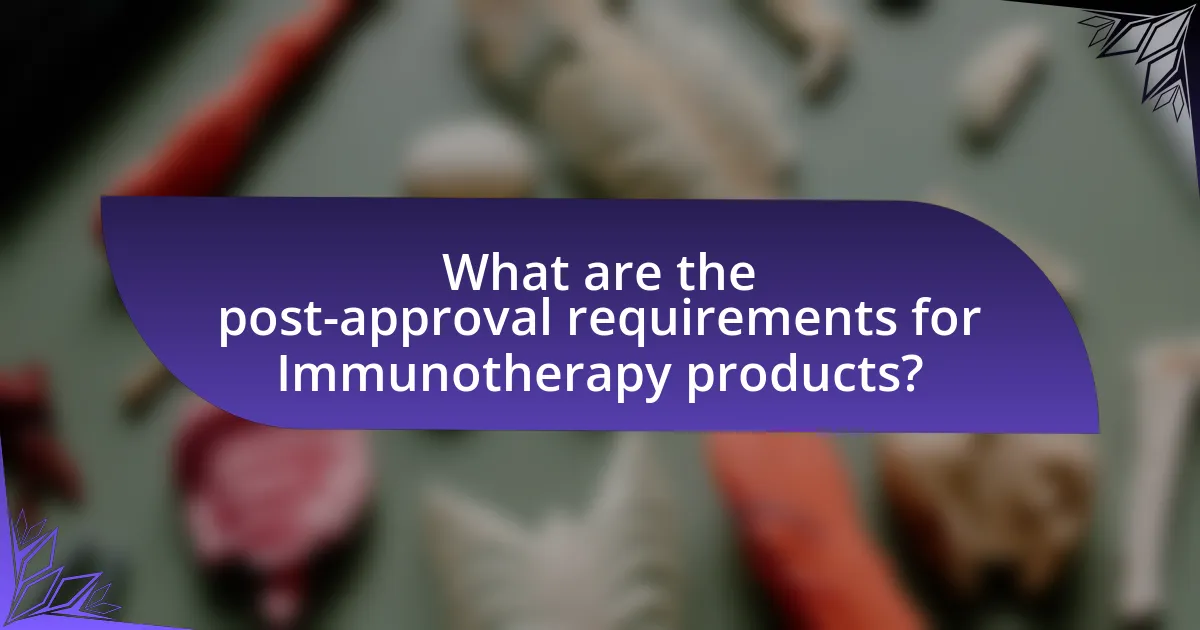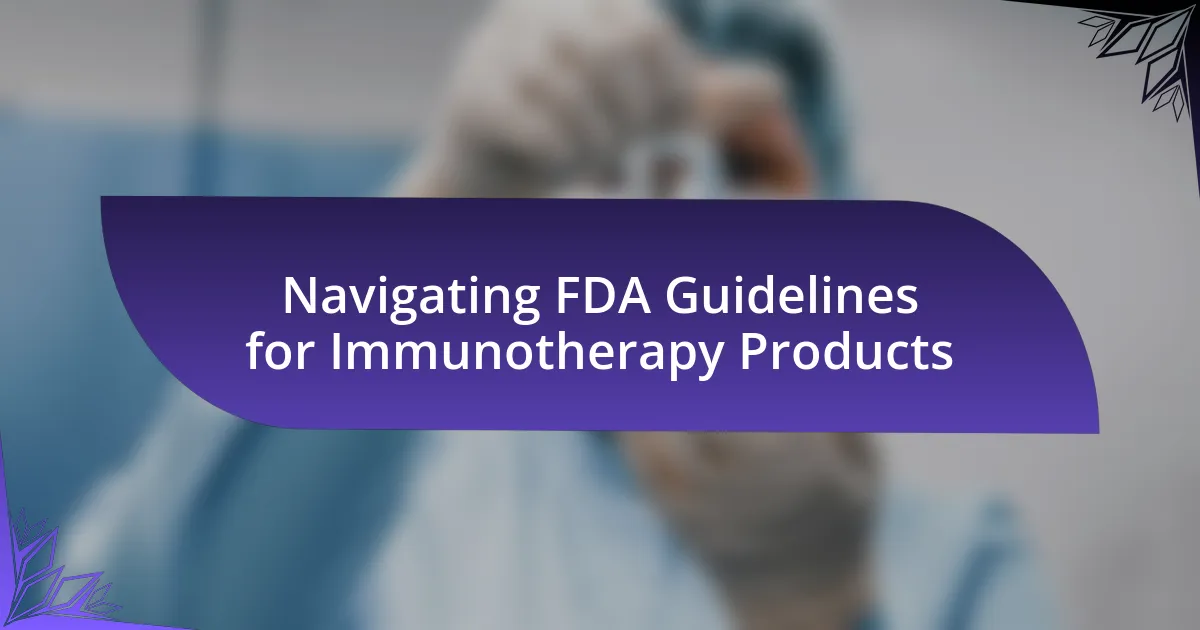The article focuses on navigating FDA guidelines for immunotherapy products, which provide a structured framework for the development, evaluation, and approval of these therapies. It outlines the importance of rigorous preclinical studies, clinical trial designs, and post-marketing surveillance to ensure safety and efficacy. Key components include the necessity for substantial evidence of clinical benefit, adherence to manufacturing practices, and the evaluation of clinical trial data. The article also addresses challenges companies face in compliance, the significance of effective communication with the FDA, and best practices for successful submissions, including the importance of patient engagement and ongoing monitoring post-approval.

What are FDA Guidelines for Immunotherapy Products?
FDA guidelines for immunotherapy products establish a framework for the development, evaluation, and approval of these therapies. These guidelines emphasize the necessity for rigorous preclinical studies, clinical trial design, and post-marketing surveillance to ensure safety and efficacy. For instance, the FDA requires that immunotherapy products demonstrate a clear mechanism of action and provide substantial evidence of clinical benefit through well-designed clinical trials. Additionally, the guidelines address the importance of manufacturing practices, including consistency and quality control, to ensure product reliability. These regulations are outlined in documents such as the FDA’s “Guidance for Industry: Clinical Considerations for Therapeutic Cancer Vaccines” and “Guidance for Industry: Immunotherapy for Cancer Treatment,” which provide detailed recommendations for developers.
Why are FDA Guidelines important for Immunotherapy?
FDA Guidelines are crucial for immunotherapy because they establish a framework for the development, evaluation, and approval of these therapies, ensuring safety and efficacy. These guidelines provide a standardized approach for clinical trials, which helps in assessing the therapeutic benefits and potential risks associated with immunotherapy products. For instance, the FDA’s guidance documents outline specific requirements for preclinical studies, clinical trial design, and post-marketing surveillance, which are essential for regulatory compliance and patient safety. By adhering to these guidelines, developers can facilitate the approval process, ultimately leading to timely access to innovative treatments for patients with conditions like cancer and autoimmune diseases.
What role do FDA Guidelines play in product safety?
FDA Guidelines play a critical role in ensuring product safety by establishing standards and protocols that manufacturers must follow during the development and approval of medical products, including immunotherapies. These guidelines are designed to assess the safety, efficacy, and quality of products before they reach the market, thereby protecting public health. For instance, the FDA requires rigorous clinical trials and comprehensive data submissions to evaluate potential risks and benefits associated with new therapies. This systematic approach has been instrumental in preventing unsafe products from being approved, as evidenced by the FDA’s authority to recall products that do not meet safety standards or pose health risks.
How do FDA Guidelines ensure efficacy in Immunotherapy products?
FDA Guidelines ensure efficacy in immunotherapy products by establishing rigorous standards for clinical trials and data evaluation. These guidelines require manufacturers to demonstrate that their products produce a significant therapeutic effect compared to a control group, typically through randomized controlled trials. For instance, the FDA mandates that immunotherapy products undergo phases of clinical testing, including Phase I for safety, Phase II for preliminary efficacy, and Phase III for definitive efficacy and safety assessments. Additionally, the FDA evaluates the statistical significance of the results, ensuring that the observed effects are not due to chance. This structured approach is designed to protect patients and ensure that only effective therapies reach the market.
What are the key components of FDA Guidelines for Immunotherapy?
The key components of FDA Guidelines for Immunotherapy include the evaluation of safety and efficacy, the requirement for robust clinical trial designs, and the necessity for comprehensive data on manufacturing processes. The FDA emphasizes that immunotherapy products must demonstrate a favorable risk-benefit profile through well-structured clinical trials that assess both primary and secondary endpoints. Additionally, the guidelines mandate that manufacturers provide detailed information regarding the product’s mechanism of action, potential adverse effects, and the consistency of the manufacturing process to ensure product quality and reliability. These components are critical for regulatory approval and are designed to protect patient safety while facilitating the development of innovative therapies.
What types of studies are required for Immunotherapy approval?
Clinical trials, including Phase 1, Phase 2, and Phase 3 studies, are required for immunotherapy approval. Phase 1 studies assess safety and dosage, Phase 2 studies evaluate efficacy and side effects, and Phase 3 studies compare the new treatment to standard therapies in larger populations. These studies must adhere to FDA guidelines, demonstrating that the immunotherapy is both safe and effective for its intended use, as evidenced by data from previous successful approvals like pembrolizumab for melanoma, which underwent rigorous testing to validate its therapeutic benefits.
How does the FDA evaluate clinical trial data for Immunotherapy?
The FDA evaluates clinical trial data for immunotherapy by assessing the safety and efficacy of the treatment through a rigorous review process. This evaluation includes analyzing data from preclinical studies, Phase 1, Phase 2, and Phase 3 clinical trials, focusing on endpoints such as tumor response rates, overall survival, and quality of life. The FDA also considers the statistical significance of the results, the robustness of the trial design, and the consistency of findings across different studies. For instance, the FDA has approved several immunotherapies based on substantial evidence from pivotal trials demonstrating improved outcomes in patients with specific cancers, such as melanoma and lung cancer.
What challenges do companies face in navigating FDA Guidelines?
Companies face several challenges in navigating FDA guidelines, particularly in the context of immunotherapy products. One significant challenge is the complexity and variability of the regulatory framework, which includes multiple pathways for approval, such as the Biologics License Application (BLA) and Investigational New Drug (IND) applications. This complexity can lead to confusion and misinterpretation of requirements, resulting in delays in the approval process.
Additionally, companies often struggle with the need for extensive clinical data to demonstrate safety and efficacy, as the FDA requires robust evidence to support claims made about immunotherapy products. This requirement can lead to increased costs and longer timelines for product development. Furthermore, the evolving nature of scientific understanding in immunotherapy means that companies must stay updated with the latest research and regulatory changes, which can be resource-intensive.
Moreover, companies may encounter challenges related to post-market surveillance and compliance with ongoing reporting requirements, which are critical for maintaining FDA approval. These challenges are compounded by the need for effective communication with the FDA, as misunderstandings can lead to further complications in the approval process.
What common pitfalls should companies avoid during the approval process?
Companies should avoid inadequate documentation during the approval process, as it can lead to delays or rejections. Comprehensive and well-organized documentation is essential for demonstrating compliance with FDA guidelines, which require clear evidence of safety and efficacy for immunotherapy products. Additionally, companies must not overlook the importance of engaging with the FDA early and often; failing to seek guidance can result in misalignment with regulatory expectations. According to a study published in the Journal of Clinical Oncology, early communication with regulatory bodies significantly increases the likelihood of successful approval outcomes. Lastly, companies should avoid underestimating the time required for the approval process; rushing can lead to incomplete submissions and missed deadlines, which are critical in the highly regulated field of immunotherapy.
How can companies effectively communicate with the FDA?
Companies can effectively communicate with the FDA by establishing clear, consistent, and transparent dialogue throughout the product development process. This involves submitting comprehensive and well-organized documentation, including pre-submission inquiries, Investigational New Drug (IND) applications, and New Drug Applications (NDA), which adhere to FDA guidelines. Regular meetings with FDA representatives, such as formal meetings or informal consultations, can also facilitate understanding and address any concerns early in the process. Furthermore, utilizing the FDA’s guidance documents and resources ensures that companies align their submissions with regulatory expectations, thereby increasing the likelihood of successful communication and approval.

How can companies prepare for FDA submissions for Immunotherapy?
Companies can prepare for FDA submissions for immunotherapy by thoroughly understanding and adhering to the FDA’s regulatory framework, which includes preclinical and clinical trial requirements. This preparation involves conducting comprehensive preclinical studies to establish safety and efficacy, followed by well-designed clinical trials that comply with Good Clinical Practice (GCP) guidelines. Additionally, companies should engage in early and ongoing communication with the FDA through meetings and consultations to clarify expectations and requirements.
Evidence supporting this approach includes the FDA’s guidance documents, such as the “Guidance for Industry: Clinical Immunotherapy Studies” which outlines specific recommendations for trial design and data submission. Furthermore, successful submissions often rely on robust data demonstrating the immunotherapy’s mechanism of action, potential benefits, and risk assessment, as highlighted in various case studies of approved immunotherapy products.
What documentation is necessary for FDA submissions?
For FDA submissions, the necessary documentation includes a comprehensive Investigational New Drug (IND) application, which must contain preclinical study data, manufacturing information, clinical protocols, and investigator information. The IND application serves as the primary document that outlines the safety and efficacy of the immunotherapy product, ensuring compliance with FDA regulations. Additionally, submissions may require a New Drug Application (NDA) or Biologics License Application (BLA) that includes clinical trial results, labeling information, and risk-benefit analysis. These documents are essential for the FDA to evaluate the product’s safety and effectiveness before approval.
How should companies structure their submission packages?
Companies should structure their submission packages by organizing them into clearly defined sections that align with FDA guidelines for immunotherapy products. Each submission package must include a cover letter, a table of contents, an executive summary, detailed descriptions of the product, preclinical and clinical data, manufacturing information, and proposed labeling.
The cover letter should summarize the purpose of the submission, while the table of contents provides a roadmap for reviewers. The executive summary should highlight key findings and the significance of the product. Detailed descriptions must include the mechanism of action, target indications, and patient population. Preclinical and clinical data should present results from studies, including efficacy and safety profiles, supported by statistical analyses. Manufacturing information must comply with Good Manufacturing Practices (GMP) and include details on the production process, quality control measures, and stability data. Proposed labeling should clearly communicate the intended use, dosing, and safety information.
This structured approach ensures that all necessary information is presented in a logical manner, facilitating the FDA’s review process and increasing the likelihood of approval.
What are the timelines associated with FDA submissions?
The timelines associated with FDA submissions vary based on the type of application. For a New Drug Application (NDA), the FDA typically takes about 10 months for a standard review and 6 months for a priority review. Biologics License Applications (BLA) follow a similar timeline, with standard reviews taking approximately 10 months and priority reviews around 6 months. Additionally, the FDA has a goal to review Investigational New Drug (IND) applications within 30 days. These timelines are established to ensure that the FDA can efficiently evaluate the safety and efficacy of new therapies while maintaining regulatory standards.
What strategies can enhance the likelihood of FDA approval?
To enhance the likelihood of FDA approval for immunotherapy products, developers should prioritize robust preclinical and clinical trial designs that align with FDA guidelines. This includes conducting well-structured Phase I, II, and III trials that demonstrate safety and efficacy, as evidenced by the FDA’s emphasis on substantial evidence from controlled studies. Additionally, engaging in early and continuous communication with the FDA can provide valuable feedback and help address potential concerns before formal submission. Historical examples, such as the expedited approval of CAR T-cell therapies, illustrate that adherence to regulatory pathways and proactive dialogue can significantly improve approval chances.
How can pre-submission meetings with the FDA be beneficial?
Pre-submission meetings with the FDA can be beneficial by providing clarity on regulatory expectations and facilitating a more efficient review process. These meetings allow sponsors to discuss their development plans, receive feedback on their proposed clinical trial designs, and address any potential issues early in the process. According to the FDA’s guidance, engaging in these discussions can lead to a better understanding of the data required for approval, ultimately reducing the risk of delays and increasing the likelihood of a successful submission.
What role does patient engagement play in the approval process?
Patient engagement plays a critical role in the approval process by ensuring that the perspectives and needs of patients are integrated into the development of therapies. Engaging patients helps to identify relevant endpoints, improve trial design, and enhance recruitment strategies, ultimately leading to more patient-centered outcomes. Research indicates that incorporating patient feedback can increase the likelihood of regulatory approval, as evidenced by the FDA’s Patient-Focused Drug Development initiative, which emphasizes the importance of patient input in the drug approval process. This initiative has led to the inclusion of patient-reported outcomes in clinical trials, demonstrating that patient engagement is essential for aligning drug development with real-world patient experiences and needs.

What are the post-approval requirements for Immunotherapy products?
Post-approval requirements for immunotherapy products include ongoing safety monitoring, efficacy assessments, and compliance with manufacturing standards. The FDA mandates that manufacturers conduct post-marketing studies to evaluate long-term effects and potential adverse reactions, ensuring that the benefits continue to outweigh risks. Additionally, companies must submit periodic safety reports and maintain adherence to Good Manufacturing Practices (GMP) to ensure product quality and consistency. These requirements are established to safeguard public health and ensure that immunotherapy products remain effective and safe for patients after approval.
What ongoing monitoring is required after FDA approval?
Ongoing monitoring required after FDA approval includes post-marketing surveillance, which involves tracking the safety and effectiveness of the product in the general population. This monitoring is mandated to identify any adverse events or long-term effects that may not have been evident during clinical trials. The FDA requires manufacturers to submit periodic safety reports, known as Periodic Adverse Event Reports (PAERs), and may also mandate Risk Evaluation and Mitigation Strategies (REMS) to ensure that the benefits of the product continue to outweigh its risks. Additionally, the FDA may require post-marketing studies to gather further data on the product’s performance in real-world settings.
How do companies report adverse events related to Immunotherapy?
Companies report adverse events related to immunotherapy by submitting detailed information to the FDA through the Adverse Event Reporting System (FAERS). This system requires companies to provide data on the nature of the adverse event, the patient’s demographics, the specific immunotherapy product involved, and any relevant medical history. The FDA mandates that these reports be submitted within specific timeframes, typically within 15 days for serious adverse events and annually for non-serious events. This structured reporting process ensures that the FDA can monitor the safety of immunotherapy products and take necessary regulatory actions based on the collected data.
What is the significance of post-marketing studies?
Post-marketing studies are significant because they provide essential data on the long-term safety and effectiveness of drugs after they have been approved for public use. These studies help identify rare adverse effects that may not have been evident during clinical trials, which typically involve a smaller and more controlled population. For instance, the FDA mandates post-marketing studies for certain drugs to monitor their performance in real-world settings, ensuring ongoing assessment of risk-benefit profiles. This ongoing surveillance is crucial for maintaining public health and safety, as it allows for timely updates to prescribing information and, if necessary, regulatory actions such as label changes or market withdrawal.
How can companies ensure compliance with FDA regulations post-approval?
Companies can ensure compliance with FDA regulations post-approval by implementing a robust quality management system that includes continuous monitoring, reporting adverse events, and adhering to Good Manufacturing Practices (GMP). Continuous monitoring allows companies to track product performance and safety, while timely reporting of adverse events ensures that any issues are communicated to the FDA, maintaining transparency. Adhering to GMP is essential for ensuring that products are consistently produced and controlled according to quality standards. These practices are supported by FDA guidelines, which emphasize the importance of post-market surveillance and risk management to ensure ongoing compliance and product safety.
What are the consequences of non-compliance with FDA regulations?
Non-compliance with FDA regulations can result in severe consequences, including legal penalties, product recalls, and damage to a company’s reputation. Companies that fail to adhere to FDA guidelines may face civil and criminal penalties, which can include fines reaching millions of dollars. For instance, in 2020, the FDA imposed a $1.5 million fine on a pharmaceutical company for violations related to drug manufacturing practices. Additionally, non-compliance can lead to the withdrawal of product approvals, forcing companies to remove their products from the market, as seen in cases where safety concerns arise. Furthermore, the reputational damage can lead to loss of consumer trust and decreased sales, impacting long-term business viability.
How can companies stay updated on changes to FDA Guidelines?
Companies can stay updated on changes to FDA Guidelines by subscribing to the FDA’s official communications, including newsletters and alerts. The FDA provides a dedicated section on its website for updates, which includes information on new regulations, guidance documents, and public meetings. Additionally, companies can participate in industry associations that often disseminate relevant information regarding FDA changes. Engaging with regulatory consultants or legal experts who specialize in FDA regulations can also provide timely insights. According to the FDA’s own resources, staying informed through these channels is crucial for compliance and effective product development.
What best practices should companies follow when navigating FDA Guidelines?
Companies should establish a comprehensive understanding of FDA guidelines by conducting thorough research and training. This involves familiarizing themselves with relevant regulations, such as the Code of Federal Regulations Title 21, which outlines the requirements for biologics and drugs. Additionally, companies should engage with FDA representatives through pre-submission meetings to clarify expectations and receive guidance tailored to their specific products.
Implementing a robust quality management system is essential, as it ensures compliance with Good Manufacturing Practices (GMP) and facilitates consistent product quality. Regular internal audits and risk assessments can help identify potential compliance issues early. Furthermore, maintaining detailed documentation throughout the product development process is crucial for demonstrating adherence to FDA requirements during inspections.
Collaboration with regulatory consultants or legal experts can provide valuable insights into navigating complex guidelines and avoiding common pitfalls. By following these best practices, companies can enhance their chances of successful FDA submissions and ultimately bring safe and effective immunotherapy products to market.
How can effective project management improve the submission process?
Effective project management can streamline the submission process by ensuring that all tasks are organized, deadlines are met, and resources are allocated efficiently. By implementing structured methodologies such as Agile or Waterfall, project managers can enhance communication among team members, which reduces the likelihood of errors and miscommunication during the submission of regulatory documents. For instance, a study by the Project Management Institute found that organizations with effective project management practices are 28 times more likely to meet project goals and business intent, which directly correlates to successful submissions in regulatory environments like the FDA. This structured approach not only improves the quality of submissions but also accelerates the overall timeline, facilitating quicker approvals for immunotherapy products.
What resources are available for companies seeking FDA guidance?
Companies seeking FDA guidance can access several resources, including the FDA’s official website, which provides comprehensive information on regulatory processes, guidance documents, and industry-specific resources. The FDA offers a variety of guidance documents that outline expectations for different product categories, including immunotherapy products, which can be found in the “Guidance Documents” section of their website. Additionally, companies can utilize the FDA’s Center for Biologics Evaluation and Research (CBER) for specific inquiries related to biologics and immunotherapies. The FDA also hosts public meetings and webinars that provide insights into regulatory updates and best practices. Furthermore, industry associations, such as the Biotechnology Innovation Organization (BIO), offer resources and networking opportunities that can assist companies in navigating FDA regulations.



